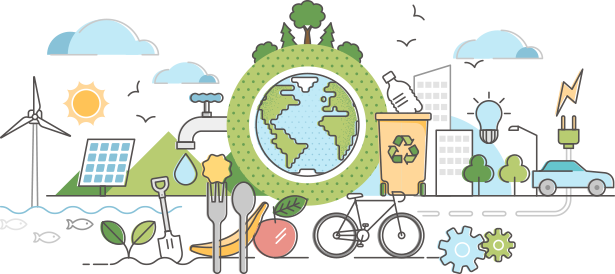Water, Energy, Food, and Ecosystems form an interconnected nexus: the WEFE nexus. For example, water supply demands energy, and water is used to generate hydropower, which alters river flows and ecosystem functioning. Water and Energy are intimately connected in cities. Irrigated agriculture for food consumes 70% of global water withdrawals. Fertilisers damage ecosystems and require energy to produce. Land conversion impacts ecosystems, and expansion in agriculture leads to water pollution, reducing the quality of ecosystem services. About one-third of global food production is lost or wasted. Food demand targets can be met with limited land expansion. Fossil fuel energy resources must be substituted for cleaner sources more rapidly. The potential for solar and wind energy is substantial. The production of energy crops conflicts with food production targets. The combustion of fossil fuels impacts the climate, hydrological cycles and ecosystems. Water demand may rise by 40% (90% in cities), energy by 50% and food by 35% by 2050.

Changes in the WEFE nexus are driven by changes in biophysical (climate, precipitation, land cover) and human (economic development, agriculture, urban growth) conditions. Continuing current consumption rates imply deepening resource and ecological deficit – when resources are extracted at a faster rate than they are replaced. To effectively manage resources and avoid conflicts between users, many relevant policies must be intelligently designed to address nexus interconnectedness across spatial scales.
The European Commission (EC) has developed an initiative for a resource-efficient Europe. However, EU-wide policies (Water Framework Directive (WFD), Renewable Energy Directive (RED), Common Agricultural Policy (CAP)), have been developed ‘sectorally’ and the EU Green Deal and UN SDGs are developed without fully considering trade-offs between objectives, leading to conflict and fragmentation with little consideration of impacts on other sectors and stakeholder relationships, with inefficient and sub-optimal markets and trade in resources as result. Recently, research has shown that billions of euros have been misspent, sometimes at the cost of environmental protection. An integrated approach is urgently needed. At the same time, it is recognized that managing the WEFE nexus effectively is extremely challenging due to the complexity and interconnectedness of the system. Current fragmentation in policy formulation, along with advances in research, offer an opportunity to improve policy design and the policy design process based on the latest science and research across disciplines. A better understanding of the impact of policies on the WEFE nexus by exploiting artificial intelligence tools to assist policy makers in guiding integrated policy design is required if sectoral synergy is to be achieved. Such improved understanding will facilitate coherent water-related policy design to achieve resource use efficiency, leverage synergies, and promote sectoral cooperation. The problem can be stated as a combination of: (i) a complex, poorly understood water-energy-food system; (b) the lack of ecosystem integration into the WEF system; (c) sectoral policy development; (d) a lack of understanding on how policies impact the WEFE nexus.
Understanding the mutual response of biophysical and human system components to policy implementation is in its infancy, a gap that NEXOGENESIS seeks to fill so that nexus policy formulation and integration can be optimised for effective streamlining while addressing resource (i.e. trade), transboundary (e.g. diplomacy), and stakeholder concerns.